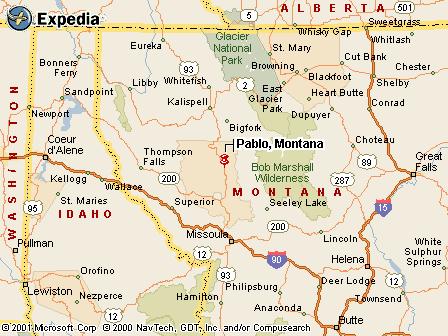|
|
Canku Ota |
|
|
(Many Paths) |
||
|
An Online Newsletter Celebrating Native America |
||
|
June 30, 2001 - Issue 39 |
||
|
|
||
|
Speaker, Drawing from Oral Histories, tells of Salish-Lewis and Clark Meeting |
||
|
by Jennifer Perez Great Falls Tribune Staff Writer |
||
|
Tribune photo by Wayne Arnst |
 When the Salish Indians first encountered the members of the Lewis and Clark Expedition, it wasn't
the two famous leaders who drew their attention. When the Salish Indians first encountered the members of the Lewis and Clark Expedition, it wasn't
the two famous leaders who drew their attention.In certain ceremonies, Salish medicine men paint their faces black with ashes, so they assumed the slave, York, the lone black member of the group, was special, said Lucy Vanderburg, director of the People's Center in Pablo on the Flathead Reservation. "It wasn't until later they found out it wasn't painted -- it was his natural color -- and he was the only black man there as a slave," Vanderburg said. "They'd never seen a white man before, or a black man," she said. "They weren't too sure what to think of the white man's pale skin, long hair and beards." Vanderburg, a Salish herself, presented the Salish account of the encounter at the Lewis and Clark Interpretive Center Friday as part of the Lewis and Clark Festival. Salish scouts spotted the Corps of Discovery approaching their camp at Ross' Hole, which is in Lolo near Missoula, on Sept. 4, 1805. The party was bedraggled and in need of care, so the chief, whose name translates to Three Eagles, instructed his warriors to bring the explorers to camp unharmed. "The chief said, 'We need to give them some buffalo ropes, to warm them up,'" Vanderburg said. They traded 12 of their fine horses to the travelers, whose own stock were exhausted. The Salish offered them food, which some declined. In his journal, expedition member Private Whitehouse, described the Salish as "the likelyest and honestst Savages we have ever yet Seen." The explorers, as well as other tribes, described the Salish as friendly with everyone they encountered, said Vanderburg, whose lecture was sponsored by the Montana Committee for the Humanities. The People's Center works closely with tribal elders to educate the public about the history of the Salish, Kootenai and Pond d'Oreille, Vanderburg said. The Salish's oral history has been recorded on 600 tapes of interviews with elders whose relatives lived in the Bitterroot Valley until 1891, she said. "I read some stories, according to so and so, about this is what the Salish said or did," she said. "This isn't according to me or to the People's Center. This is what our elders told us, and undoubtedly they heard it from their elders." |
|
|
|
Salish & Kootenai Tribes |
|
|
||
|
|
||
| Canku Ota is a free Newsletter celebrating Native America, its traditions and accomplishments . We do not provide subscriber or visitor names to anyone. Some articles presented in Canku Ota may contain copyright material. We have received appropriate permissions for republishing any articles. Material appearing here is distributed without profit or monetary gain to those who have expressed an interest. This is in accordance with Title 17 U.S.C. section 107. | ||
|
Canku Ota is a copyright © 2000, 2001 of Vicki Lockard and Paul Barry. |
||
|
|
|
|
|
The "Canku Ota - A Newsletter Celebrating Native America" web site and its design is the |
||
|
Copyright © 1999, 2000, 2001 of Paul C. Barry. |
||
|
All Rights Reserved. |

